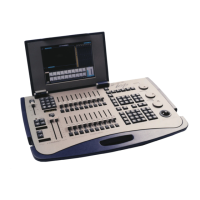Disk Operations
The functions performed under Disk Operations are:
• Format diskettes
• Upgrade Service Tools software
• Record the System Configuration
• Load the System Configuration
Formatting disks
Keypresses Results/Comments
1. Press F6 Disk Operations
2. Press F1 Format Disk
Reads and displays the files recorded on the
disk.
3. Press F1 Format 1.44 Mb.
or
F2 Quick Format
Use this option is formatting a new 1.44 m.
diskette.
Use this option to format a diskette that has
already been formatted. Reformatting a diskette
will erase all the information previously
recorded.
4. Press F6 to confirm format
command or press any key
to cancel.
Recording the system configuration
This function records the system configuration which includes the number of channels,
scrollers, dimmers, amount and type of moving devices, as well as the special function and
special number data.
It is important to record the system configuration to eliminate guesswork when
reconstructing a show. Each configuration recording is given a file name and text. Load the
configuration for your show if the current system configuration differs from the system
configuration on which the show data was recorded.
Configuration files are accessible only in Service Tools and do not appear when examining
the diskette in the Load menu.
Keypresses Results/Comments
1. Press F6 Disk Operations
2. Press F4 Record Config The system prompts you to enter a file name. Enter a
file name (number) on the numeric keypad
3. Press F4 Record S.T. File A text window opens. You may enter a textual
description for the configuration file on the
alphanumeric keyboard.
4. Press F1 Enter When completed the message Recording Done is
displayed.

